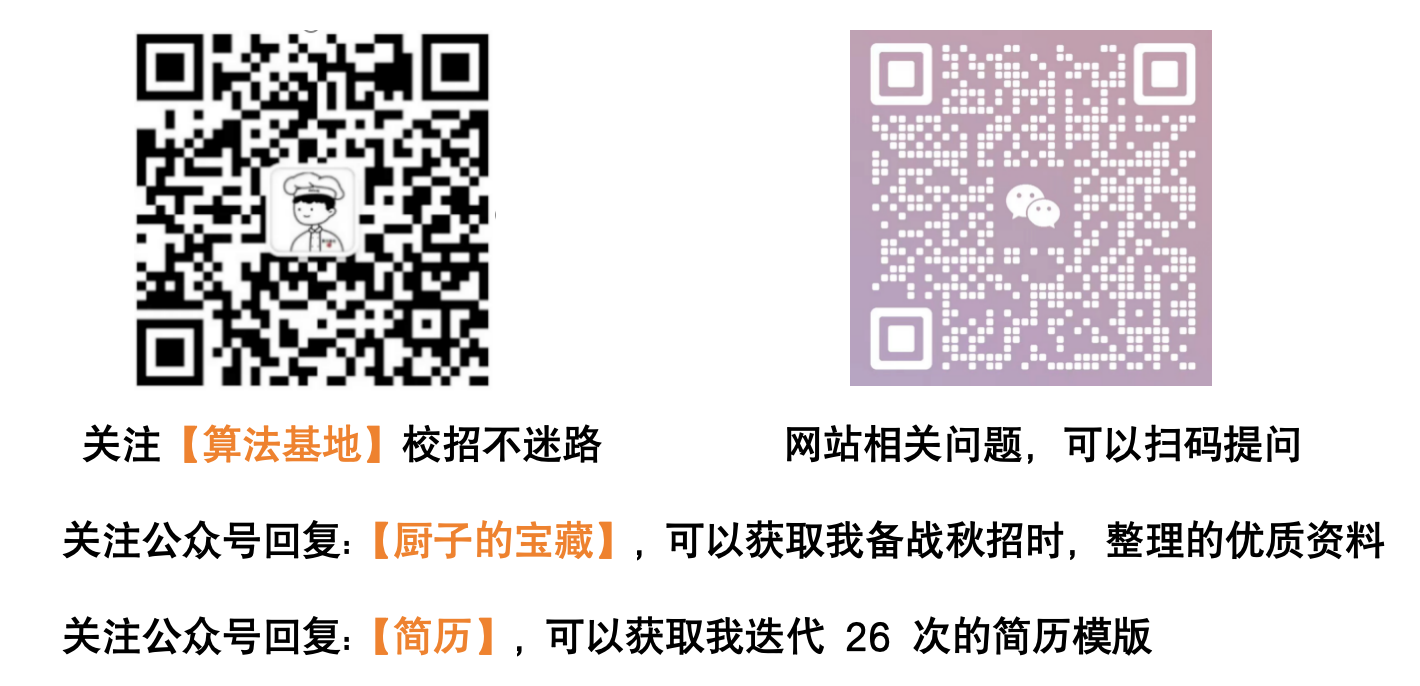12、两个链表的第一个公共节点
大约 5 分钟数据结构算法算法基地面试链表双指针剑指Offer哈希表刷题程序厨校招社招
题目描述
今天给大家带来一个不是那么难的题目,这个题目的解答方法很多,只要能 AC 的就是好方法,虽然题目不是特别难但是也是剑指 offer 上的经典题目所以大家要记得打卡呀。
然后今天我们的链表板块就算结束啦。周末的时候我会对链表的题目做一个总结,俗话说温故而知新嘛。好啦废话不多说,我们一起来看一下今天的题目吧!
题目描述:
输入两个链表,找出它们的第一个公共节点。如下图,返回黄色结点即可。

题目表达是不是也很简单,这个题目我的方法一共有两个,一种就是用 HashSet 进行存储,一种就是利用双指针,大家有更好的可以在下面讨论呀。
HashSet
这个方法是比较简单的,主要思路就是,先遍历一个链表将链表的所有值都存到 Hashset 中,然后再遍历另一个链表,如果发现某个结点在 Hashset 中已经存在那我们直接返回该节点即可,代码也很简单。
代码
Java Code:
public class Solution {
public ListNode getIntersectionNode (ListNode headA, ListNode headB) {
ListNode tempa = headA;
ListNode tempb = headB;
//定义Hashset
HashSet<ListNode> arr = new HashSet<ListNode>();
//遍历链表A,将所有值都存到arr中
while (tempa != null) {
arr.add(tempa);
tempa = tempa.next;
}
//遍历列表B,如果发现某个结点已在arr中则直接返回该节点
while (tempb != null) {
if (arr.contains(tempb)) {
return tempb;
}
tempb = tempb.next;
}
//若上方没有返回,此刻tempb为null
return tempb;
}
}
C++ Code:
class Solution {
public:
ListNode * getIntersectionNode(ListNode *headA, ListNode *headB) {
ListNode * tempa = headA;
ListNode * tempb = headB;
//定义Hashset
set <ListNode *> arr;
//遍历链表A,将所有值都存到arr中
while (tempa != nullptr) {
arr.insert(tempa);
tempa = tempa->next;
}
//遍历列表B,如果发现某个结点已在arr中则直接返回该节点
while (tempb != nullptr) {
if (arr.find(tempb) != arr.end()) {
return tempb;
}
tempb = tempb->next;
}
//若上方没有返回,此刻tempb为null
return tempb;
}
};
双指针
下面这个方法比较巧妙,不是特别容易想到,大家可以自己实现一下,这个方法也是利用我们的双指针思想。
题目解析
下面我们直接看动图吧,特别直观,一下就可以搞懂。

是不是一下就懂了呀,我们利用双指针,当某一指针遍历完链表之后,然后掉头去另一个链表的头部,继续遍历。因为速度相同所以他们第二次遍历的时候肯定会相遇,是不是很浪漫啊!
代码
Java Code:
public class Solution {
public ListNode getIntersectionNode (ListNode headA, ListNode headB) {
//定义两个节点
ListNode tempa = headA;
ListNode tempb = headB;
//循环
while (tempa != tempb) {
//如果不为空就指针下移,为空就跳到另一链表的头部
tempa = tempa != null ? tempa.next: headB;
tempb = tempb != null ? tempb.next: headA;
}
return tempa;//返回tempb也行
}
}
C++ Code:
class Solution {
public:
ListNode * getIntersectionNode(ListNode *headA, ListNode *headB) {
//定义两个节点
ListNode * tempa = headA;
ListNode * tempb = headB;
//循环
while (tempa != tempb) {
//如果不为空就指针下移,为空就跳到另一链表的头部
tempa = tempa != nullptr ? tempa->next: headB;
tempb = tempb != nullptr ? tempb->next: headA;
}
return tempa;//返回tempb也行
}
};
好啦,链表的题目就结束啦,希望大家能有所收获,下周就要更新新的题型啦,继续坚持,肯定会有收获的。
贡献者@jaredliw注:
在这里带大家来看看一些其他的解题方法,虽然没有双指针有效,但还是值得一试。
- 两个链表各遍历一次,找出长度。根据长度差 k,让较长的那个链表先走 k 步。之后再两个指针一起走,由于起点一样,两个指针必将一起到达公共节点。
- 将其中一条链表的头和尾相连,公共节点就是环的入口,直接套用之前学过的算法就可以啦。(这解法看得我拍腿叫好)





